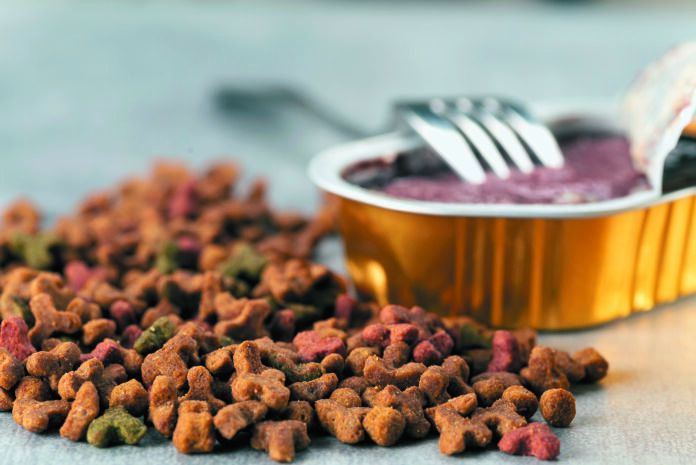Most people feed their dogs all dry food, or almost all. This is especially the case for those with larger dogs. A single bag of dry food lasts for many meals, and the kibble is convenient to store in a bag at the bottom of the pantry and scoop out as needed. Cans or little plastic tubs of wet food last only a meal or two, so each trip to the supermarket requires the purchase of many small containers at once. And all those little metal or plastic packages then need to be rinsed and set aside for recycling or end up in landfills.
The price difference stops some people cold, too. When we compared dry food to a similar wet food from the same company, we found that for every dollar spent on the dry variety, you’d get almost 1,600 calories for your dog. Every dollar spent on the canned, by contrast, would net your dog only about 250 calories. That’s more than a six-fold difference in price per calorie. Even if you have a small dog weighing only 20 pounds, it comes to a considerable expenditure over time.
So why would some people choose wet food over dry? Is it a health issue?
Not usually. For most healthy dogs, dry or canned food works just fine. But for pets with certain health conditions, wet food might make a better choice.
Potential reasons for choosing wet food
- Urinary tract problems. Some dogs with urinary tract issues require more water for their health than they feel like drinking. Since wet food is 78 percent water on average (and ranges up to 85 percent water) and dry food averages 10 percent water, it’s easier to make sure a dog who needs more water is getting at least some of it by eating rather than by constantly trying to coax him to drink from his bowl.
- Kidney and bladder stones. High water consumption, much higher than most dogs will drink naturally, can help promote the dissolution of — or prevent the formation of — kidney and bladder stones in predisposed dogs. Feeding wet foods can make it possible to dramatically dilute the urine to reduce crystal and stone formation.
- Underweight, picky pet. “Wet food is sometimes a good choice for pickier dogs who might otherwise not be consuming enough calories,” says board-certified veterinary nutritionist Cailin Heinze, VMD. It’s potentially more palatable to many dogs than dry kibble, “probably in part because it often has a higher fat content than dry food,” she says. Fat carries flavor. Wet food also is often higher in protein than dry. And sometimes, dogs just find the moist texture more palatable.
- Difficulty eating. Pain in the mouth or other parts of the GI tract — from dental problems, an oral tumor, or a neurological deficit that can make the mechanics of swallowing difficult — might make wet food a better choice. It’s easier to mouth and may be easier to get down.
A potential reason for choosing dry food
Along with a lower price and storage convenience, dry food might be better for your dog’s teeth than wet — at least in certain cases. Some studies have shown better dental health in dogs that eat dry versus wet foods, but the reasons are likely much more complex than just the amount of moisture. Ingredients, texture, and other components also play a role, making it hard to simplify the comparison to just dry versus canned.
That said, some dry foods are specifically formulated to maintain dental health. If you would like to feed a diet that has been tested to reduce plaque or tarter, look for a product that has the VOHC seal, meaning a seal from the Veterinary Oral Health Council. To earn this seal, the company must provide data proving that their diets meet certain standards for prevention of the build-up of plaque and tartar (hardened plaque) on the teeth. No wet foods have the seal.
Note: Regardless of the diet that you choose to feed, you still should get regular dental cleanings for your dog at the veterinarian’s office and brush your pet’s teeth every day. That’s where the lion’s share of oral health protection comes in. You can’t count on food alone.
Bottom line
If your dog likes dry food and does not have a problem swallowing and also does not have an illness that requires him to drink more water, there’s no reason to consider switching to wet. By the same token, if your dog enjoys wet food and it fits into your budget and you don’t mind the extra work that goes into replacing it more frequently and finding storage space, there’s no compelling reason to switch to dry. In other words, it’s hard to make the wrong choice for a healthy dog. Dry vs. wet is one nutrition issue most people with dogs don’t have to sweat.
People often assume that a dry food and a wet food made by the same company with the same or similar names have similar ingredients and nutrition profiles, so they mix and match without thinking about it. But the dry and wet versions of a food can have dramatically different nutrient levels. “Treat them as differently as you would treat any two dog foods,” Dr. Heinze advises. “Don’t assume that what you find on one label will be the same on the other.” This is particularly important if your pet needs lower amounts of certain nutrients, such as fat or sodium.






My Pug gets exclusively canned food to which I add extra water. AS a puppy she had crystals and bladder stones and I don’t want a repeat. She is now 9 years old and no signs of any UTI’s.
10 year old Lab is fed the raw diet from The farmers Dog plus the golden paste and shows no signs of lameness or stiffness.
Abigail, Farmers dog is slow cooked, not raw. Raw would be questionable for me. However my two big boxer boys love their farmers dog! Dry burnt kibble just can’t be good for a dog’s with by products and questionable “meals“ their entire life- most everything good is cooked away for ease of storage and “meals” added to most of them to make ‘em cheap – I’m not that lazy to feed frozen and delivered to my house healthy food to them.
I mix kibble with boiled chicken or sardines (in water), vegetables. Berries, cucumbers, carrots for snacks.